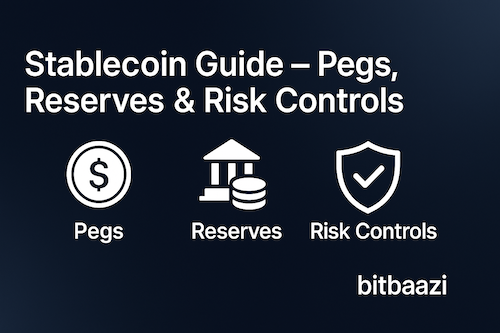Stablecoin Guide — Pegs, Reserves & Risk Controls
▽ Summary
- Pegs track a reference asset via reserves and redemption.
- Reserves: cash, T‑bills, MMFs; attestations improve trust.
- Risk controls: network match, 2FA, allow‑list, test send.
These dollar‑linked tokens aim to move value quickly and predictably across chains. This guide explains pegs and reserves, how redemption works, and how to use a Stablecoin safely in real workflows.
What it is
These tokens aim to track a reference asset—often USD—through issuance, redemption, and governance.
Funds are minted when cash enters the issuer and burned on redemption. Targeting $1 depends on liquid reserves, robust operations, and market makers that keep on‑chain prices near par across venues.
Pegs & reserves
A peg relies on liquid reserves and predictable redemption; transparency ties circulating supply to $1.
Issuers commonly hold cash and short‑dated U.S. Treasuries, sometimes via regulated government money market funds with separate custody and monthly third‑party assurance. Disclosure cadence and asset quality drive user confidence.
Issuance & redemption in practice
Mint/burn flows expand or contract supply based on customer demand.
Institutional users mint and redeem directly; most individuals access liquidity on exchanges and wallets. Keep proof of funds and TXIDs, and confirm any cut‑off times to avoid settlement gaps on busy days.
Key risks & mitigations
Operational、market、and legal risks can break parity; process controls reduce exposure.
Operational: wrong network, missing memo/tag, or compromised keys cause loss—use allow‑lists, 2FA, and test sends. Liquidity: thin books or stressed markets widen spreads—stage exits and avoid peak congestion. Legal: read terms on redemption rights, fees, and blacklisting to understand recourse.
Regulation snapshot
EU rules for fiat‑backed tokens apply, while U.S. proposals continue to evolve.
In the EU, ART/EMT regimes under MiCA entered application in 2024 with guidance on redemption planning and disclosures. Issuers highlight attestation programs and reserve segregation to align with regulatory expectations.
Where they’re used
Common uses include trading, settlements, payroll, and remittances; align networks with counterparties.
Pick the chain your counterparty supports, match address formats precisely, and confirm fees and confirmation targets. For cross‑venue transfers, start small and scale once crediting is verified.
■ Takeaways
Trust rests on liquid reserves, timely attestations, and clear redemption. Operational discipline—network match, allow‑lists, test sends—keeps transfers predictable. Keep audit trails for support and compliance.
作用与设计
这些代币以美元等参考资产为目标,通过发行与赎回机制维持面值。
现金与短期美债等高流动性资产构成储备;定期披露与第三方鉴证提升可验证性。本文仅在此处提及一次 Stablecoin,其余以“美元锚定代币”等泛称指代。
储备、赎回与信息披露
稳定目标依赖充足储备与可预期赎回,信息披露把流通量与 $1 锚定。
常见做法是将大部分储备放在政府货币市场基金或受监管银行托管,并提供月度鉴证与资产构成报表;透明度与流动性越高,场内外价格越接近面值。
主要风险与应对
操作、流动性与法律条款均可能引发偏离;流程管控可降低风险。
操作:网络不匹配、缺失 memo/tag 或私钥泄露会导致损失—启用白名单与 2FA 并先小额测试。流动性:在拥堵或盘整时点点差扩大—分批赎回并避开高峰。法律:阅读发行方条款,了解赎回资格、费用与黑名单规则。
监管概览
欧盟 MiCA 对法币支持型代币已生效,美国层面仍在推进法案与规则。
ART/EMT 框架自 2024 年起进入适用阶段,监管机构强调赎回计划、透明度与风险隔离;合规披露与第三方鉴证逐步成为行业常态。
常见场景
交易结算、跨境汇款与薪酬发放较常见;以对手方支持的网络为准。
严格匹配链与地址格式,确认费用与确认数;跨平台转移应先小额试转,验证入账后再扩大规模。
役割と設計
米ドルなどの参照資産に連動させるため、発行と償還の仕組みで面値を維持します。
準備資産は現金や短期国債など高流動性が中心で、定期のアテステーションが信頼性を補完します。本稿では Stablecoin をこの一度のみ用い、以後は「米ドル連動トークン」等で表記します。
準備資産・償還・開示
面値維持は潤沢な準備資産と予見可能な償還が前提で、開示が $1 との結び付きを担保します。
政府マネーファンドや受託銀行での分別管理、月次の第三者保証が一般化し、流動性と透明性が高いほど取引所/チェーン間の価格はパリティに近づきます。
主なリスクと対処
オペレーション・流動性・法的条件の各リスクでパリティが崩れ得ます。
オペ:ネットワーク不一致やメモ漏れ、鍵流出が損失要因—許可リストと 2FA、少額テストを徹底。流動性:板が薄い時間帯はスプレッド拡大—分割して償還、混雑回避。法的:発行体の条件(償還資格・手数料・ブラックリスト)を事前確認。
規制のスナップショット
EU の MiCA は法定通貨連動型に適用開始、米国は制度設計が進行中です。
ART/EMT の適用は 2024 年から順次開始し、監督当局は償還計画や透明性の要件を提示。開示と第三者保証は実務上の標準になりつつあります。
利用場面
取引・決済・送金・給与などで広く利用;相手先が対応するネットワークを選択。
アドレス形式とネットワークを厳密に一致させ、手数料や確認数を事前確認。プラットフォーム間の移動は小口で着金確認後に拡大。
